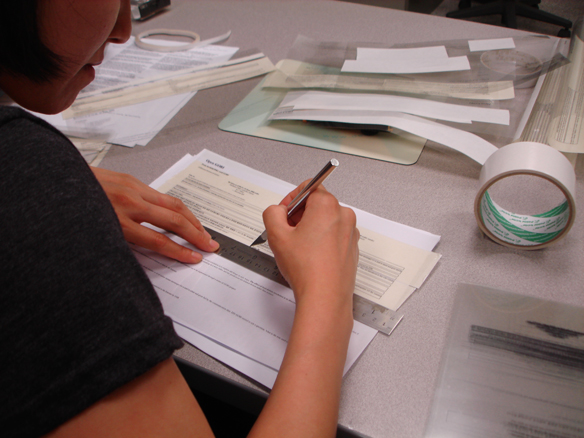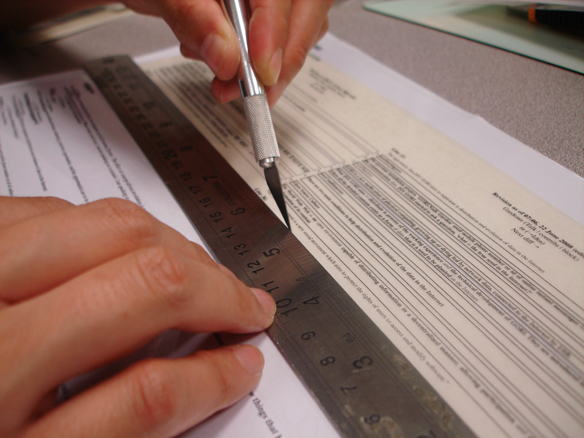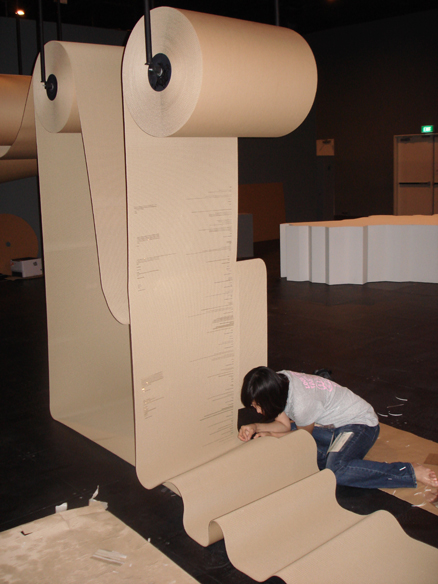Jee Oh’s live-performance and installation seed_1216976400 (2008) translates the evolving process of communication, revisions, and adaptations that form a shared Wiki page into the exhibition space, thus making the invisible movements and detours that happen online to be experienced in the physical space.


Jee Oh, seed_1216976400, installation shots; ISEA2008, Singapore
Interview with Jee Oh
Christine Takengny: Can you describe the process of the installation, seed_1216976400 that you performed at the National Museum of Singapore in 2008?
Jee Oh: seed_1216976400 was presented at the juried exhibition of ISEA2008 (International Symposium on Electronic Art), which was held in Singapore. The installation was formed of four giant corrugated recycled paper rolls hanging from the ceiling. Each roll visualised the history of text revisions of wiki web pages. The aim was to map the development process of a new media artwork that I developed with two collaborators over the course of 6 months. I cut off every single text line of the revisions after they were printed on transparent paper and pasted them on the hanging rolls. While I added and pasted one text line after the other the rolls were pulled longer and longer and dragged on the floor until they eventually interwove. The form followed the content.
C.T.: Why were you interested in looking at Wikis?
J.O.: I find the process more significant than the result when it comes to the creation of ideas. Once the concept is initiated, the actual development of a new media artwork is technically complicated and often requires artists from different backgrounds to collaborate. I wanted to translate the evolving process of their communication into a physical form and I found that a wiki website would be a good tool for realising my idea. Wiki websites using wiki software can make it easy to create, collaboratively edit and navigate contents of interlinked web pages.
C.T.: Can you explain the title of the art work?
J.O.: The name indicates a still frame in time of the wiki-documented content evolution since the creation of a web page. The 10 digits ‘1216976400’ is in fact the converted Unix time stamp of 2008-07-25 00:00:00 GMT (Greenwich Mean Time) which was the first day of the ISEA2008 exhibition. I believe any online contents are seeds that can grow into different kinds of plants by different users. By sharing the evolving process online, I wanted my then completed artwork to be a new seed for someone to start from. That is why ‘seed’ is added in the title.

Jee Oh, seed_1216976400, installation shots; ISEA2008, Singapore
C.T.: How did the public react to the installation? If you re-staged it, would you do it in the same way?
J.O.: Most people are used to information visualisation in graphical forms on screens and they probably expected similar experiences when they came to the ISEA2008 exhibition. I had mainly two very opposite reactions about my work. While some questioned if the paper cut and paste could be regarded as electronic art, others liked the metaphoric use of paper rolls representing the history and process of text revisions that often remain invisible. If I were to re-stage the piece, I would open and share the cut and paste procedure with the audience.
C.T.: Do you think that knowledge production has become more democratic through Wikis? Or do you think that in the virtual world, when it comes to establish what is the 'official truth', the hierarchies of power are the same as those that are at stake in the 'real world'?
J.O.: Medium and power are inseparable and wiki software helps distribute power to online users in terms of information access. So, in my opinion, ‘truth’ is now to become a subjective issue generating more complex systems of hierarchies to exist online compared to off-line.
Jee Oh's website.
Connecting the Dots, Page 2 of 6.